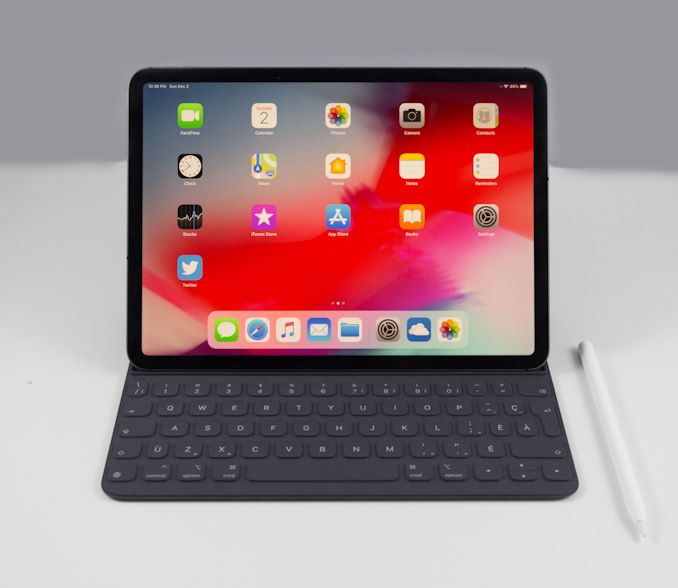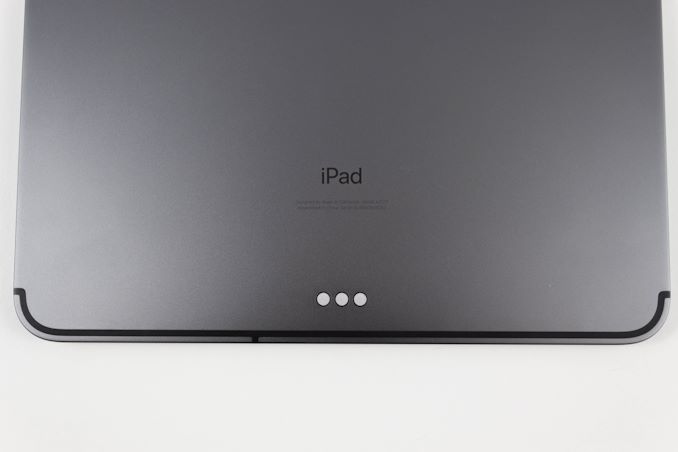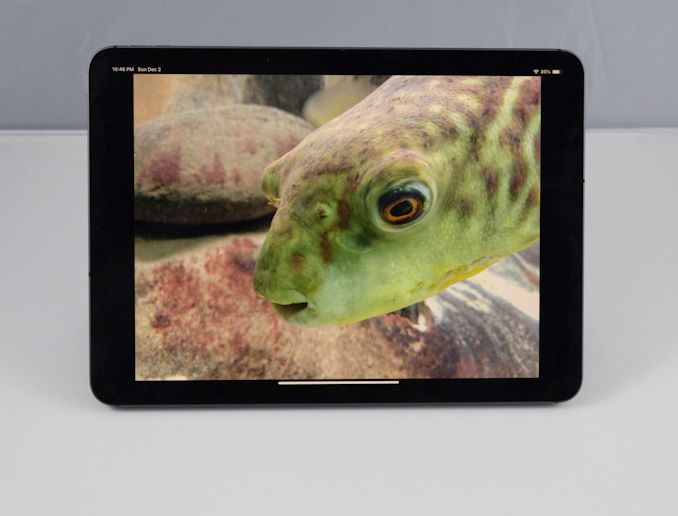The 2018 Apple iPad Pro (11-Inch) Review: Doubling Down On Performance
by Brett Howse & Andrei Frumusanu on December 4, 2018 10:00 AM ESTFinal Words
Apple calls the 2018 iPad Pro the iPad they’ve always dreamed of building. The new iPad Pro offers a completely new design, with some great new features, so it’s not difficult to see why they say that. The first thing anyone will notice is the new thinner bezels, offering up a modern take on the iPad idea.
Let’s start with the display, since it is really a highlight of this iPad. The performance of it is simply outstanding, and Apple offers arguably the best display in any consumer device with the iPad Pro. The 120 Hz ProMotion makes scrolling incredibly smooth. The True Tone adjustment brings a pleasant look to the display in any lighting condition. And the color accuracy is pretty much second to none. Really the only thing missing is HDR – and the battery life hit that would entail in such a portable device would probably not be worth it.
Apple’s SoC efforts have been leading the industry, and the A12X in the iPad Pro offers plenty of performance, but without breaking the power budget. With four Vortex cores for performance, coupled with four Tempest cores for efficiency, and all eight cores available all the time, you get both the burst performance needed for everyday workloads, along with the incredible battery life you’d expect in a tablet. On the GPU side, the seven GPU cores offer 75% more GPU hardware than the iPhone XS, and more memory bandwidth as well. The GPU and CPU both share the sameLPDDR4X memory, with up to 6 GB, and the performance is excellent.
Apple’s new Pencil is also a nice improvement over the outgoing model. A small thing like one flat side makes the Pencil not roll away on you, and also doubles as a connection to the iPad Pro where it magnetically docks for charging. It is a much-improved design over the original, and it is double improved by having a capacitive button on near the tip which can do various functions depending on the application being used.
The new Smart Folio Keyboard is also a nice improvement, offering a much easier setup, but it is not as clear of a win as the Pencil. The extra slot for a second position is nice, but it makes the iPad a bit wobbly and unstable if used anywhere but a nice, flat desk. The keys also don’t offer backlighting, and the definitely should for the price. iOS also shows from time to time that it was not originally intended to be used with a keyboard, which can be frustrating.
And while the hardware is fantastic, iOS is starting to feel like it is holding back the iPad Pro in the productivity realm. There is a lot of performance on tap, but getting access to it can be difficult. It really comes down to the app developers to pull the performance out of this iPad, but due to the fragmented iPad market, they may just target the lowest common denominator, which is often the case. A game like Civilization VI comes by default running at a very low resolution so that it will work well with the older iPads Pros, and will take a developer update to unlock any more fidelity, since the end user has no control over that on iOS for the most part. It makes it easy, but it isn’t always the best experience.
At least on an app basis, the silver lining here is that Adobe bringing their Creative Cloud suite to the iPad is definitely a big win for Apple. Done well, and it should showcase the performance of the tablet, along with the Pencil, in ways that many other apps won’t take advantage of.
If you are a fan of iOS, and you have a workflow that is suited to its operation, there’s little doubt the new iPad Pro models are going to be a great addition, but considering the price increase over the base iPad, you really have to need that performance to justify the iPad Pro 11-inch. Apple also charges a pretty hefty sum to upgrade the internal storage, and the accessories really add on to the price tag as well.
With all of that said, there’s no doubt in my mind that the latest iPad Pro is the best iPad ever. It’s the fastest. It offers great battery life. The display is second to none. But it is still, at its nature, an iPad. Apple has been working on the productivity angle for a few generations now, and while this is their best stab at it yet, the iPad Pro is still in that awkward gap between a content consumption device and a traditional laptop or the Windows convertibles that the original iPad inspired. What you get then is a device that's certainly a lot more professional than the base iPad and a lot more useful for productivity use cases, but also something that feels more like a larger, more expensive iPad than the kind of top-tier machines the iPad Pro is intended to compete with.













145 Comments
View All Comments
MonkeyPaw - Tuesday, December 4, 2018 - link
For what it’s worth, Affinity Photo on my 2017 iPad Pro performs much better than Affinity Photo on my 2017 5K iMac. Perfectly usable on iOS, not good at all on an i5-7500 with Radeon Pro 570.tipoo - Tuesday, December 4, 2018 - link
That sounds specific to that program.As this article shows, a port going either way doesn't always go great for the secondary platform, and Affinity is mobile first.
thunng8 - Tuesday, December 4, 2018 - link
incorrect, Affinity Photo for ipad is a port of the mac version.Spunjji - Wednesday, December 5, 2018 - link
Just checked this out after responding another comment of yours - the results are interesting! The GPU in your iMac has something like 3x the resources of a Vega 10, which itself seems to be in the same performance ballpark as this Apple chip. Your iMac requires that the GPU do 4x the pixel-processing work your iPad needs to. It sounds like the performance difference is greater than just that, though - but we've already established that the iPad GPU is running at a lower precision. The GPU in A12X can also discard a lot of data before rendering that the Polaris GPU can't, so with those factors taken into account the performance difference isn't so shocking. Still impressive what Apple can do with solid optimisation, good design and a process shrink, though!vFunct - Tuesday, December 4, 2018 - link
Apple should have really led the way in converting pro-apps to iPad pro.It really needs a pro video editor, like Final Cut Pro X, and not the cut-down iMovies editor, for location YouTube videographers.
It could also use some pro-level audio software like full Logic, and not GarageBand.
pvdw - Tuesday, December 4, 2018 - link
I'd really like to see some comparisons to Chromebooks. There's a number of recent ones that are aiming for the same premium portable productivity category, e.g Pixel Slate, HP x2, etc.FrankGu - Tuesday, December 4, 2018 - link
GRID™ Autosport is another choice of cross-platform game on iOS, which may be used for comparison. This game seems to require more performance than Civilization VI on graphics and it needs iOS 11 which looks like based on Metal 2. Although the game's graphic settings are not open to users now, but they should be similar to MEDIUM level on PC.Brett Howse - Tuesday, December 4, 2018 - link
If you have that game on iOS does it have the benchmarking mode that is part of the PC install? The nice thing about Civ is that it does have the debug mode ported over.FrankGu - Tuesday, December 4, 2018 - link
It doesn't have a benchmark mode on iOS version :(tipoo - Tuesday, December 4, 2018 - link
". And the color accuracy is pretty much second to none. Really the only thing missing is HDR – and the battery life hit that would entail in such a portable device would probably not be worth it."Curiously the last gen iPad Pros did advertise HDR, but this year they stopped doing that, probably because the LCD doesn't have the 1000 nits to cover it (nor is it an OLED which could do it with 600). But, it does play HDR content as best it can, for a decent enhancement over not having it at all